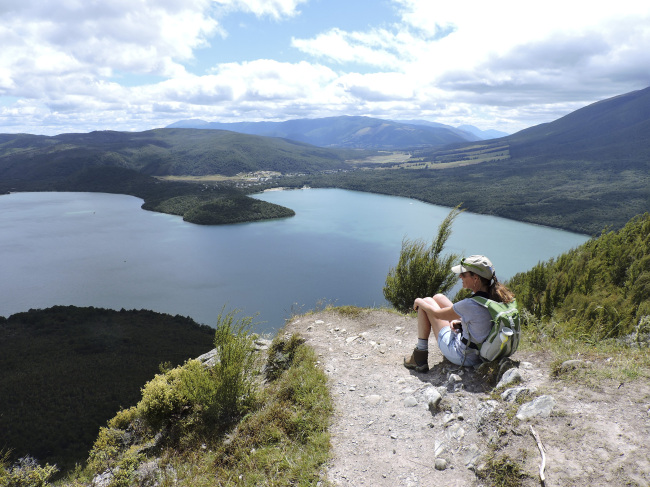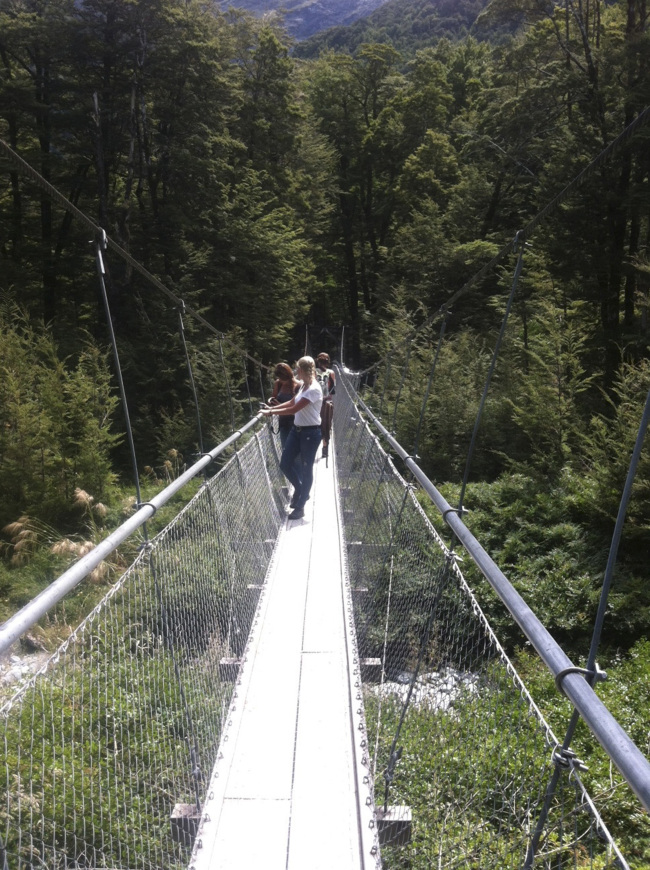New Zealand’s hiking trails offer one spectacle after another
By KH디지털2Published : March 25, 2016 - 14:09
The hike had been invigorating — invigorating, as in just this side of grueling. A 6-mile ascent into Mount Aspiring National Park had brought us to an overlook of Routeburn Falls, a thundering multilevel cascade of crystalline water (standard for New Zealand) jumping from the rock face above our heads and rushing into the deep valley below us. There we could see the Routeburn River winding through the high-shouldered Humboldt Mountains on its way to Lake Wakatipu.
We were breathless not only because of the impressive scenery but because we had run out of time. Sights along the Routeburn Track earlier in the day had slowed us down, and in order to see the falls, we had sprinted the last mile up the steep trail. We were sweating, struggling for air and, most importantly, feeling that the extra effort had been completely worth it.
Other than the danger of overextending yourself, hiking New Zealand’s abundance of trails is almost never disappointing. In fact, if you come all this way and don’t take advantage of them, you’ve truly missed out.
We were breathless not only because of the impressive scenery but because we had run out of time. Sights along the Routeburn Track earlier in the day had slowed us down, and in order to see the falls, we had sprinted the last mile up the steep trail. We were sweating, struggling for air and, most importantly, feeling that the extra effort had been completely worth it.
Other than the danger of overextending yourself, hiking New Zealand’s abundance of trails is almost never disappointing. In fact, if you come all this way and don’t take advantage of them, you’ve truly missed out.

And the Kiwis work hard to make hiking attractive. The maintenance on the trails we hiked was impressive: crushed-rock trail beds; comfortable clearance even in the most dense areas of the beech- and fern-dominated rain forests; boardwalks that meander over wetlands; and well-built, if sometimes unnerving, suspension bridges that span the roiling creeks.
Richard Davies, a recreation manager for New Zealand’s Department of Conservation, said about $65 million is pumped into the country’s park areas annually. Much of that money is devoted to trail development and making sure they are maintained properly.
“It hasn’t happened by chance,” Davies said of the manicured trails. “All our staff is working on certain service standards – how much vegetation is cleared, the gradient of the track, whether the watercourses are bridged or not. We can provide a really consistent service. Wherever you go in the country you get a similar experience.”
From our hikes in the Bay of Islands on the North Island, to the southern regions of Fiordland National Park on the South Island, we found this to be true.

And there is good reason for the effort. The spectacular scenery this island nation has to offer is unsurpassed. Director Peter Jackson didn’t just film his J.R.R. Tolkien epics here because he didn’t want to leave his home country. The vertical landscapes, whether they anchor themselves in mountain rivers, broad lakes or the Pacific Ocean, perfectly lend themselves to fantasy.
What we were seeing often felt unreal: The knife-edged ridges on the mountains, the steep faces of which are frequently laced with waterfalls. The dense, verdant forests filled with calling birds and towering giant ferns that make you feel as if you’ve stumbled into some prehistoric world. The glittering lakes, where the water is so clear you can see the bottom until reflection gets in your way many yards from shore.
All of these, and more, make this a country of constant surprises. And hiking is one of the best ways to see it.
Originally, we had planned to backpack some of the trails, throwing our lot in with a largely younger crowd frequently seen not only on the trails but in the cities and by the sides of the roads, their thumbs extended. But when my girlfriend broke her arm four days before we were due to fly out of Los Angeles International Airport, we had to alter our itinerary. Nevertheless, she was determined not to be slowed down, and we got in plenty of trail time and plenty of those wonderful surprises.
What we call hiking, folks here refer to as trekking or tramping, and it’s a bit different than what we’re used to in the United States. There aren’t many places on the popular trails where you can head out into the wilderness and plunk your tent down when you think you’ve found a good campsite.

On many trails, you can set up camp only in designated campgrounds. On some, trekkers can only stay overnight in huts, many of which are rather primitive. Davies said the oldest one his agency manages was built in the 1860s by early farmers. Some, such as the one at Routeburn Falls, are relatively new and — while it is a dormitory — the bunked beds are partitioned off in a way that provides a moderate degree of privacy.
New Zealand’s most famous trail, the Milford Track in Fiordland, is also its most restrictive. Both ends of the track are accessible primarily by ferry. Hikers can only do the route in one direction, and you have to have a permit or be with a guide to access the trail at all. Reservations are hard to come by. When I looked in October, shortly after we decided to travel to New Zealand, there were no reservations available until April.
Davies said the coveted spots usually get booked a year ahead of time. He didn’t know the exact timetable but said reservations for the 2016-17 season would soon open.
Booking campsites and huts is required on the more popular trails. January weekday spots for the Routeburn Track, perhaps the next most popular after the Milford Track, were still available when I checked in late November. But if you go during New Zealand’s summer, January to April, there is plenty of competition, especially for space in the huts. There are cancellation penalties, but you are best off booking as early as possible.
However, there are other options. On less popular trails, huts are often available on a first-come, first-served basis and, according to Davies, you can camp wherever you find a good spot. If you venture onto some of these trails, don’t expect the carefully tended paths of the major tracks.
“We have many that are essentially just a few markers,” Davies said. “Every park or piece of land has trails like that. They tend to be not advertised as much.”
But choosing the “advanced” or “expert” category on the conservation department’s website will direct you to such trails.
We may tackle some of those next time around. But on this trip we found ourselves on some of the more popular routes.
We started our South Island trip in Nelson, a quiet town but one with enough restaurants to make it interesting. After an overnight stay at the very comfortable Bretton’s Retreat bed and breakfast amid the vineyards of nearby Brightwater, we took a 45-minute drive to Lake Rotoiti, one of the Nelson Lakes.
Here there are several trails around the lake and up adjoining valleys. We took one of two steep trails to the top of Mount Roberts, a 3,800-foot climb, where there was a spectacular view of the lake below and of the steep slopes of the St. Arnaud Mountains to the south.
Trail distances in New Zealand’s parks are typically measured in time rather than distance. We found the times to be pretty liberal estimates. The Mount Roberts loop is listed at five hours. We finished in 31/2 without pushing it.
Our drive for the remainder of the day took us through the Marlborough region, famous for its wineries and its distinctive sauvignon blancs, and down the picturesque east coastline, where we saw ample numbers of surfers and sea lions, to Kaikoura. The seaside village is known for its crayfish, or spiny lobster, and ocean excursions to see whales or swim with wild dolphins.
One of the things we had hoped to see was Mount Cook, New Zealand’s highest peak, in its Southern Alps. So the following day, we drove through the busy city of Christchurch and miles of green farmland to reach the tiny resort town of Lake Tekapo.
Along the way, we stopped at the occasional roadside stand to buy blueberries, peaches and, of course, kiwi. We were surprised to discover that the quality and price of the produce was pretty comparable in the supermarkets. And while the cost was a bit higher than in the States, we did not run into the exorbitant prices we’d been warned about. The same held true for hotel rates and dining out.
We left Lake Tekapo in the morning rain. The weather hadn’t improved much by the time we had skirted the shores of glacier-fed Lake Pukaki with its steel gray surface, and reached the trail leading into the Aoraki/Mount Cook National Park. An hour’s hike took us over roaring streams and along the base of cliff faces cut with waterfalls. When we reached the trail’s end at the milky Hooker Lake, the clouds had only slightly lifted and offered us only occasional glimpses of the shoulders of Mount Cook. Nevertheless, the scenery was stunning.
New Zealand’s weather can be dicey, even in summer. These are, after all, rain forests that we were hiking through. They’re called rain forests for a reason.
Three days later, when we were trekking along the southern end of the 30-mile-long Routeburn Track, we took a detour to Key Summit. There we were perched above a dramatic landscape. I know this because it said so in large letters on the sign in front of us. It was one of those sloped metal signs that depict the view before you, labeling all of the important geographic features.
To our left was Mount Christina or, to the Maori, Te Taumata o Hinepipiwai. Far below, cradled in a glacial cirque, was Lake Marian. Wrapped in a drizzling fog whiteout, we could see none of it.
There was nothing else to do.
I took a picture of the sign.
Fortunately, this was the exception. Though we dealt with overcast skies on many of the days we were in New Zealand, the clouds often added to the landscape, rather than detracting from it. They were part of the experience.
But, as if bestowing a parting gift upon us, the following day was sunny. We had returned to the North Island and had started our final day with a hike on the coast directly west of Auckland, above Mercer Bay, where the coastline rivals Big Sur’s.
At one headland stands a carving of the Maori maiden Hinerangi, who married a young chieftain but lost him at sea. Legend says she died on this spot of a broken heart, looking out to sea, hoping for the return of her love. Her face is said to appear on a nearby cliff side.
I wasn’t able to pick out her features, but that hardly diminished the beauty of the place. Nor did her sad tale dampen my enthusiasm or appreciation for what we had experienced along the trails we tramped in New Zealand.
IF YOU GO
Hiking: Track and trail information can be found at doc.govt.nz. You can also make hut and campsite reservations through the site. (Tribune Content Agency)


















![[Today’s K-pop] Treasure to publish magazine for debut anniversary](http://res.heraldm.com/phpwas/restmb_idxmake.php?idx=642&simg=/content/image/2024/07/26/20240726050551_0.jpg&u=)